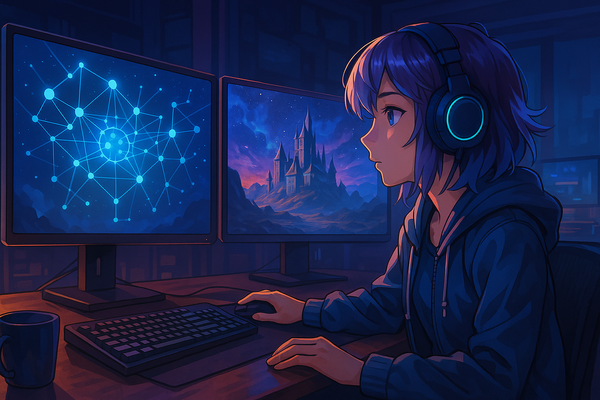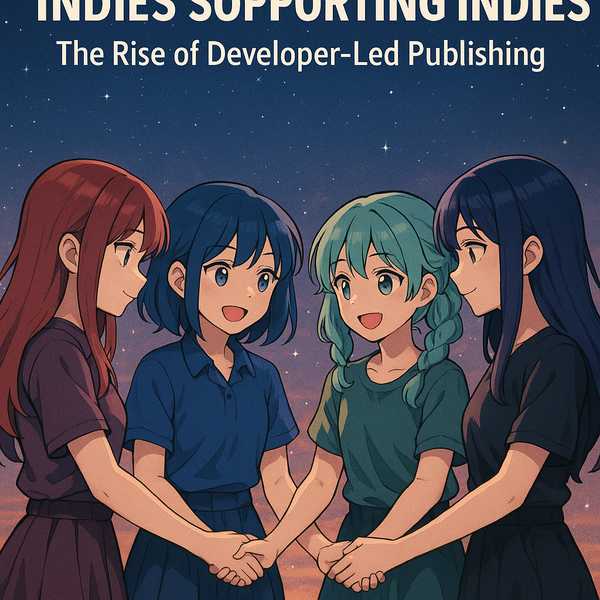How indies are innovating multiplayer: Beyond battle royales and FPS games
In the past few years, independent game developers have been pushing the boundaries of multiplayer design in ways that mainstream AAA shooters and battle royale titles rarely explore. While big-budget studios churn out iterations of similar competitive formulas, indies are experimenting with fresh mechanics, creative cooperative modes, asynchronous interactions, and novel community features. This article delves into how indie games from 2023–2024 are innovating multiplayer gaming beyond the familiar tropes of battle royales and FPS deathmatches. We’ll look at new cooperative adventures, clever competitive hybrids, asynchronous worlds, and community-driven experiences that showcase the creativity thriving in the indie scene.
Asynchronous worlds and user-generated challenges
One major area of innovation has been asynchronous multiplayer – games where players impact each other’s worlds without necessarily being online at the same time. A standout example is Meet Your Maker (2023), a game that lies at the intersection of Dungeon Keeper and Mario Maker. In this first-person builder-raider game, players construct deadly outpost fortresses filled with traps and guards, then raid other players’ outposts for resources (Meet Your Maker is the next game from Dead by Daylight dev Behaviour Interactive | Eurogamer.net). It’s an asynchronous experience at heart: your creations are challenged by others while you’re offline, and you in turn infiltrate bases designed by strangers. Unlike traditional competitive games, Meet Your Maker is “less interested in competitive stakes and more about players sharing creativity and earning rewards for it” (Meet Your Maker review: Saving humanity one gruesome murder at a time | Shacknews). The result is a cycle of creativity and challenge – you’re not just trying to win, you’re trying to craft something cunning enough to stump the community and then improve your design based on how players tackle it.
Meet Your Maker also introduces novel community features to connect builders and raiders. Every outpost built will get raided by other players – the game ensures even new creations get exposure (Meet Your Maker: Keeping Your Enemies Close - Xbox Wire). After a raid, the attacker can leave behind preset accolades describing the outpost (e.g. “Brutal” or “Ingenious”), giving builders feedback on their work. Builders can watch replay recordings of anyone attempting their level – “the Replay System lets you watch any raider take on your outpost and revel in the joy of their failure – or pound your fist on the desk as they breeze through”. This turns each base into a learning tool and a shared experience between its creator and challengers. There’s even a “Skull System” that marks where raiders died in your base, showing their name, rank, and cause of death, and rewarding you with resources at those points. To top it off, Meet Your Maker has a Social Raids mode that allows any outpost to be searched and played by name (outside the normal matchmaking), so creators can directly share levels with friends or stream viewers – these user-generated levels “remain alive forever” for fun even when they’re no longer part of progression. All of this is happening asynchronously, emphasizing creativity and community over live head-to-head combat. (For those who do want company, the game also supports co-op for both building and raiding with a friend).
Another inventive asynchronous multiplayer concept is Phantom Abyss, which left early access with a 1.0 release in early 2024. Phantom Abyss is a “massive asynchronous multiplayer game” set in an infinite cycle of deadly temple runs (Phantom Abyss on Steam). Each temple is procedurally generated and only one player in the world will ever conquer it – if someone retrieves the relic at the end, that temple closes forever for everyone else. All other players only get one attempt to try that temple, and if they die or settle for a lesser relic halfway, the temple is gone for them. The twist is that you’re not truly alone: as you attempt a temple, you see the ghosts of other players who tried and failed, their phantoms replaying their final runs in real time (Phantom Abyss is an asynchronous multiplayer title about treasure hunting, coming to Early Access | TheSixthAxis). These ghost runners turn each level into a learning opportunity – you can watch where others triggered traps or fell to their doom, and use that knowledge to progress further. Succeed, and you become the only person to ever claim that temple’s ultimate treasure, with your name effectively etched in the game’s history. This design creates a thrilling sense of a shared world without needing concurrent matchmaking. It’s a race against the temple itself and the memories of players who came before. Indie devs Team WIBY have essentially made a single-player Indiana Jones adventure feel like a massively connected event, just without direct PvP combat. The idea of one-and-done levels that exist for all players until beaten (and then vanish) is a bold multiplayer concept we rarely see in big-budget games.
Beyond these, other indies are toying with asynchronous or non-simultaneous multiplayer elements. Death Stranding (though AAA, inspired many indies) demonstrated the appeal of indirect cooperation by leaving structures or messages in others’ worlds; indie titles are picking up that baton in new ways. Even small design touches – like global puzzles solved collectively by a community or ghost data in racing games – have been embraced by independent creators to make players feel subtly connected. The key is that not every “multiplayer” experience needs to be about shooting each other in real-time. Indies are showing that shared worlds and user-generated challenges can unite players in novel, less combative ways.
Cooperative adventures with a twist
Cooperative multiplayer is another space where indie games are shining with innovation. Instead of treating co-op as an afterthought or a linear campaign, many indie titles put cooperation at the core of the design, often requiring communication and coordination in ways AAA games seldom attempt.
Take Barotrauma (1.0 released in 2023) – a 2D co-op submarine simulator that’s been described as a “Space Station 13-y co-op sub game” (Barotrauma is a Space Station 13-y co-op sub game | Rock Paper Shotgun). In Barotrauma, up to 16 players assume different roles on a submarine exploring the depths of Europa’s ocean, and together they must manage a bewildering array of systems and survive threats. One player might be the captain steering the sub and navigating sonar; others are engineers maintaining a nuclear reactor, mechanics fixing hull breaches, medics treating injuries, or security officers fending off sea monsters. The submarine is a complex, interconnected machine – damage or malfunctions can cascade into dynamic disasters. For example, losing power affects life support and engines; a leak in one compartment might flood others if not sealed; a mismanaged reactor can meltdown. This complexity demands true teamwork: players have to constantly communicate and divide tasks to keep the sub “ship-shape and alien-free”. Barotrauma creates tension and emergent storytelling akin to a sci-fi horror movie, where every member of the crew plays a critical part.
What really makes Barotrauma special (and uniquely indie) is the potential for role-play and betrayal. Just like the cult-classic Space Station 13 that inspired it, Barotrauma allows servers to enable secret traitor roles or side objectives for certain crew members. This means your co-op partner might secretly be tasked with sabotaging the mission or “clowning around” in ways that put everyone in danger. The game doesn’t force betrayal – it’s an option left to the community’s preference – but that very possibility adds a layer of social intrigue on top of the mechanical cooperation. “Help your teammates survive, or make sure no one does,” as the official game description cheekily puts it (Home - Barotrauma). Moments of chaos, like discovering a traitor disabling the oxygen generator, or simply panicking as a massive creature breaches the hull, make Barotrauma a story generator for groups of friends. It’s the kind of deep, systems-driven co-op experience that big studios rarely risk building, but it has flourished in the indie scene thanks to its richness and replayability.
Indies are also reinventing co-op in lighter, more intimate ways. Bread & Fred (2023) is a perfect example of a small indie title with a big cooperative idea. On the surface it’s a cute pixel-art platformer about two penguins climbing a snowy mountain. The catch: the two players are tethered together by a short rope for the entire climb (Bread & Fred Review: Between a Rock and a Hard Place - The Punished Backlog). This simple mechanic changes everything – you and your partner have to coordinate every jump, swing, and slide. If one player slips, they’ll yank the other down with them unless the partner anchors at just the right moment. The rope essentially demands constant communication and trust; it’s a bit like a three-legged race in videogame form. This design leads to moments of hilarious failure and triumph. Successfully timing a tandem leap over a chasm after five failed attempts can have both players high-fiving in real life, whereas a tiny mistake that sends you tumbling back down half the mountain might induce groans and laughter. “This mechanic puts a heavy emphasis on player-to-player communication” in an unforgiving platforming landscape. Bread & Fred turns cooperative play into a true test of friendship (in the best way possible) and delivers a kind of shared satisfaction – and shared frustration – that solo play can’t match. It’s definitely not the kind of carefully calibrated experience a AAA studio would think to make, but it has earned acclaim for being fresh and fun (even if it’s rage-inducing at times).
Another burgeoning trend in co-op is asymmetric roles and perspectives. Games like the We Were Here series and 2022’s The Past Within have shown that two players can experience different viewpoints or information and still work together. In The Past Within, for instance, one player is in the past and another in the future, solving puzzles that affect each other’s timeline – neither can see the other’s world, so communication is the only way to progress. Recent indie escape-room titles continue to iterate on this idea, proving that cooperation can be about more than just combat support or generic team play; it can be about truly complementary asymmetric gameplay. Even when not strictly “multiplayer” in the traditional sense, indies have toyed with cooperative elements in storytelling (e.g. interactive narrative games allowing multiple players to vote on choices, as seen in titles like As Dusk Falls which supports 8 players voting on story decisions). All these innovations focus on one core principle: cooperation is at its most rewarding when players feel like they genuinely need each other. Indie developers, unencumbered by the need to design for massive mass-market audiences, are exploring that principle in clever ways, from shared ropes to split realities.
Fresh competitive formats and hybrid genres
Indie multiplayer innovation isn’t limited to cooperative or asynchronous play – many indies are also redefining competitive multiplayer with hybrid genres and creative twists that go beyond the typical shooter or battle royale formats. Instead of simply copying the Fortnite or Call of Duty formulas, these games mix genres or introduce wholly new objectives.
A shining example from 2023 is Deceive Inc., a multiplayer game that combines social stealth, espionage, and hero shooter elements. Imagine a competitive Hitman mixed with the deception of Among Us, set in a stylish spy-vs-spy backdrop. In each match of Deceive Inc., a dozen players are secret agents infiltrating a facility filled with NPCs. Everyone is disguised as an innocuous staff member or guest, trying to blend into the crowd while completing objectives – and sniffing out rival players. There’s only one winner (or one winning team), so while you all sneak toward the prize, you’re also hunting each other. What makes it brilliant is how it flips the script on typical “find and kill” gameplay. As one reviewer put it, “one of the best things Deceive Inc. has going for it is that it’s very much not a ‘find the killer’ game like Among Us... Deceive Inc is more like the old Assassin's Creed multiplayer modes, or a competitive version of Hitman. Around a dozen spies enter a map disguised in a sea of NPCs. Your job is to blend in, find intel, and steal a golden briefcase deep within the vault.” (My favorite multiplayer game of 2023 so far is basically competitive Hitman | PC Gamer). In other words, it’s competitive stealth – a tension-filled game of cat-and-mouse where everyone is both cat and mouse. You might spend minutes tailing a suspicious “janitor” NPC only to discover it really was just an NPC… or have a tense stare-down when you realize another character copying AI behavior is actually a human opponent doing the same to you. Matches often explode into brief shootouts or chases, but only after long periods of quiet subterfuge. Deceive Inc. also features diverse agents with gadget loadouts (holograms, tripwires, disguises, etc.), adding a hero shooter-style layer of strategy on top of the social gameplay. It’s the kind of genre mashup that feels completely fresh, and it scratches an itch that AAA publishers have largely left untouched since the days of Assassin’s Creed’s multiplayer modes. Despite its critical praise as “the most exciting and original multiplayer game of the year so far” in early 2023, Deceive Inc. flew under the radar of many – but it has a dedicated following that appreciates its unique blend of deception and competition.
Another new competitive frontier being explored by indies is the fusion of PvP and PvE known as the “extraction” or PvPvE genre. The big-budget space has seen games like Escape from Tarkov or Hunt: Showdown popularize the idea of dropping players into a hostile environment with both AI enemies and player competitors, challenging them to grab loot and escape alive. Indie developers have taken this concept in exciting new directions. The poster child here is Dark and Darker – a medieval fantasy take on extraction dungeons that became a breakout hit during its 2023 playtests. Dark and Darker essentially asks: what if you combined the classic co-op dungeon crawler (think D&D or Diablo) with the high-stakes PvP of a battle royale? The result is a hardcore first-person PvPvE dungeon crawler where you and a small squad venture into monster-filled catacombs and contend with other player teams who are after the same treasure (Dark and Darker has a rival in new multiplayer RPG coming to Steam). You might be exploring a crypt, fighting skeletons and spiders, when suddenly another trio of players ambushes you from behind – now it’s a fight to the death, after which the survivors still have to find an exit portal before the dungeon collapses. The tension is incredible, because death means losing all the loot you’ve gathered. Deciding when to extract is a mind game in itself: do you cut your losses and escape early with modest loot, or delve deeper for the big prize and risk running into better-armed players? As one preview described, this format “integrates the high-tension extraction format of Escape From Tarkov with a gorgeous fantasy setting,” where you go in with “trusted companions, seeking treasure and battling both the denizens down below and other intrepid adventurers… then decide when to make good your escape, hopefully before an accident, mistake, or betrayal causes you to lose it all”.
Dark and Darker’s massive popularity (even amid legal challenges that had it briefly removed from storefronts) proved that indie studios can innovate in competitive design just as much as in co-op. By merging genres – in this case, dungeon crawler RPG and high-stakes PvP shooter – they created something neither fully co-op nor purely competitive, but a thrilling mix of both.
Indies are also finding competitive fun in other genres where AAA titles have less presence. Party Animals (2023) took the goofy physics-based brawler formula (popularized by Gang Beasts) to new heights of polish and online play, letting friends clobber each other as floppy ragdoll animals. It’s essentially a party fighting game – a genre you won’t see topping sales charts, but one that delivers pure chaotic joy in a local or online multiplayer session. Likewise, Omega Strikers (2023) ventured into the relatively uncrowded space of arcade sports combat – essentially imagining a 3v3 game of air hockey crossed with a MOBA. In Omega Strikers, teams try to smack a puck into the opponent’s goal, but each player controls a character with unique abilities (fire punches, tornado kicks, etc.) to intercept the puck or KO rivals, all in quick top-down matches. The game is free-to-play and features full cross-platform play (PC, console, mobile) with quick matchmaking, showing that even a small studio can deliver a smooth competitive experience on par with bigger games. These titles might not have the marketing might of FIFA or Overwatch, but they resonate with players looking for competitive multiplayer that isn’t just another shooter. By focusing on niche but fun concepts – slapstick brawling, fantasy sports, social deception, you name it – indie developers are broadening the spectrum of competitive play.
Community-Driven features and new tech approaches
Beyond the gameplay modes themselves, indie multiplayer games are innovating in how they leverage communities and technology. One area of note is the integration of live audience interaction into gameplay – something few AAA games have attempted. A pioneering effort here is Cult of the Lamb (2022, with major 2023 updates) – a primarily single-player rogue-lite that turned streaming and community interaction into a multiplayer-like feature. From launch, Cult of the Lamb included a Twitch extension called Companion of the Lamb that allows viewers of a streamer to participate in the game. Streamers can run raffles so a viewer becomes an in-game cult follower named after them, and those followers can even vote on in-game events to “Help or Hinder” the player (Cult of the Lamb New Twitch Integrations Update - Cult of the Lamb Guide - IGN). In 2023, the developers expanded this integration: viewers could now spend channel points to make their follower send a message that appears in the streamer’s game, vote en masse on important decisions (like which cult member to sacrifice), and even see a live overlay list of all cult members (viewer-created or otherwise) and their status. Essentially, Cult of the Lamb transforms a single-player experience into a kind of asymmetric multiplayer where the Twitch chat becomes a part of the game’s logic. The community isn’t just watching; they’re influencing the game in real time. This kind of design is increasingly viable for indies and speaks to a future where the line between playing and spectating blurs. We’ve seen hints of it in games like Jackbox Party Pack (where audience members join via phones) and Twitch Plays Pokémon (a crowd-controlled game experiment), but modern indies are building these features more directly into their games to create participatory experiences that scale from 1 to 1000 players via streaming platforms.
Indie devs are also quick to adopt new networking technologies and platforms to make multiplayer more accessible. Cross-play, once a rarity, is now almost expected for any indie multiplayer game – and indeed many of the games mentioned (from Deceive Inc. to Omega Strikers) launched with full cross-platform play, ensuring that small player bases aren’t split by platform. Some are leveraging proven tech like rollback netcode (first popularized in fighting games) for smoother online play in genres like platform fighters and even co-op action games, reducing latency issues that would otherwise hurt gameplay. Others are using creative solutions to achieve scale: BattleBit Remastered (2023), while essentially an FPS, is noteworthy as a small-team project that successfully hosted 254-player battles by prioritizing low-poly graphics and network optimization – accomplishing on an indie budget what usually only AAA Battlefield titles attempt. On the flip side, indies are also embracing dedicated servers, mod support, and community-hosted servers in a way many modern AAA games avoid. This openness allows communities to self-organize and keep games alive for years. For example, Barotrauma’s robust modding and player-run server ecosystem has kept its cooperative chaos fresh and customizable.
Finally, indie multiplayer games often iterate in “early access” or open beta phases with close involvement from the community. This means the players themselves help shape balance and features, effectively becoming part of the development process. It’s not unusual for an indie title to add new modes or rules based on player feedback – the developers can afford to be more experimental and responsive without a massive publisher dictating their every move. The result is often a game that, by the time it hits 1.0, has honed in on what its community finds fun (and trimmed what isn’t). This agile approach has led to surprisingly polished and well-balanced multiplayer experiences despite limited resources.
Pushing boundaries beyond the mainstream
From trap-filled base-building challenges and ghostly asynchronous races, to tethered penguin platforming and spy-vs-spy showdowns, indie games in 2023–2024 have shown a remarkable range of multiplayer innovation. They’re proving that “multiplayer” doesn’t always have to mean 100 players dropping onto an island with guns, or two teams racing for kill counts. New modes of play – cooperative, competitive, and everything in between – are emerging that emphasize creativity, communication, deception, and community in novel ways. Indie developers have the freedom to take risks on unorthodox ideas, and as we’ve seen, those ideas can lead to some of the most memorable multiplayer experiences around.
Crucially, these innovations are starting to influence the wider industry. Concepts pioneered by indies often get noticed by larger studios (for instance, the social stealth of Deceive Inc. or the community integration of Cult of the Lamb could inspire features in the next AAA titles). At the very least, they push the conversation forward on what multiplayer can be. As we move beyond the dominance of battle royales and FPS games, the experiments happening in the indie space today might well define the multiplayer hits of tomorrow. For gamers, it’s a great reason to broaden your horizons and try these indie experiences – you’ll not only have a blast in a way you haven’t before, but you’ll be supporting the creative forces that keep our industry moving forward.




